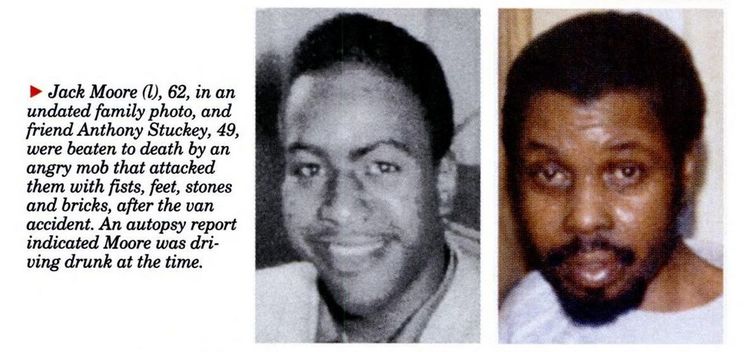
08/09/2002
The other day I read a story in the Washington Times about two men who were beaten to death after their car accidentally ploughed into a crowd of lowlifes standing on a streetcorner.[Angry mob beats 2 to death, Washington Times, August 1, 2002]
The story made no mention of the race of either victims or criminals, and I searched for other stories on the same incident.
Google’s news search gave me stories from the Washington Post, Boston Globe, Baltimore Sun, Miami Herald, the Guardian in the UK, and even News24.com from Capetown, South Africa, none of which mentioned the race of either the victims or the criminals.
Naturally, I suspected that a black mob had beaten two white men to death, and that this, like other hate crimes that don’t fit the liberal template, would be massively underreported. I couldn’t confirm this on the web and thought I'd have to call up people in the Chicago PD, or the local papers, to get the truth.
But, lo and behold, the next day I read in James Taranto’s OpinionJournal that everyone else suspected the same thing:
What’s Black and White and Red All Over?
Tuesday night on Chicago’s South Side, a mob attacked and killed a driver and his passenger after a traffic accident in which the driver, Anthony Stuckey, lost control of his truck and hit three women, injuring one critically. Race was not a factor in the incident, but the reactions we heard from several readers say something interesting about the racial attitudes of American news media and their consumers.
Early wire reports of the melee made no mention of the race of anyone involved, which led some to read between the lines and assume that the mob and the accident victims were black and the murder victims were white. This turned out to be mistaken; today’s Chicago Tribune has pictures of Stuckey and passenger Jack Moore, both of whom were plainly black. [VDARE.COM Note: the Tribune still doesn’t say they were black, or that their assailants were black.]
Our readers were operating according to a stereotype, but it is a stereotype with some basis in reality. [Here he’s talking about the stereotype of the media, not racial stereotypes.] The standard practice in newsrooms is to omit references to race, especially in crime stories, unless race is relevant — an eminently sensible policy in theory. But the exception for "relevance" is an invitation to mischief, because determining whether race is relevant or not can be an exercise in subjectivity — or political correctness.
If a white mob had attacked a black motorist, there’s little doubt reporters would have presented it as a racist "hate crime" and it would have become a huge national story. And if a black mob had attacked a white motorist? It’s easy to imagine reporters and editors deeming race "irrelevant" — or deeming its mention potentially explosive — and playing down the racial angle, just as our readers suspected they did.
This may amount to an argument for including racial references more often in crime stories. In this case, their omission led at least some readers to assume falsely that a pair of murders were racially motivated. In retrospect it’s clear that the victims' race was relevant to the story, if only to dispel the suspicion that it was relevant to the crime.
My question: why does Taranto think it’s "eminently sensible in theory" to omit the race of both assailant and victim in a crime story?
What happened to the public’s right to know, the news that’s fit to print, journalistic integrity?
As for reporters and editors deeming the mention of anti-white violence to be "potentially explosive," do they really think that white people are going to start a race riot in 2002?
And if they are worried about the "potentially explosive" effects, why did they spend so much ink on the Diallo case, on police shootings in Cincinnati, on the Rodney King arrest?
Journalists who suppress this kind of information are wedded to a vision of society in which race doesn’t matter, in which stereotyping is a matter of unworthy suspicions of innocent people.
The problem is that that’s not the society in which we live.
Last year I wrote that
It’s frequently the case that the minor detail of a suspect’s race will not be mentioned even when it’s the description of someone who’s still at large. If you are one of the 70 million Americans who get their news largely from TV networks, you might not know that most interracial violence is committed by African-Americans.
Most people really know who is more likely to commit a crime, on the average. (Steve Sailer has said he’s only ever met one man who didn’t engage in "profiling" for personal safety, and the man said, actual quote: "I've already been mugged three times!")
But media blackouts on race and crime produce what Marxists call a "false consciousness". People don’t know the facts about crime. And they can’t decide on public policy because they don’t have those facts.
The US has freedom of the press. No-one is forcing journalists to suppress this information.
Why don’t they just do their job?
August 09, 2002
This is a content archive of VDARE.com, which Letitia James forced off of the Internet using lawfare.